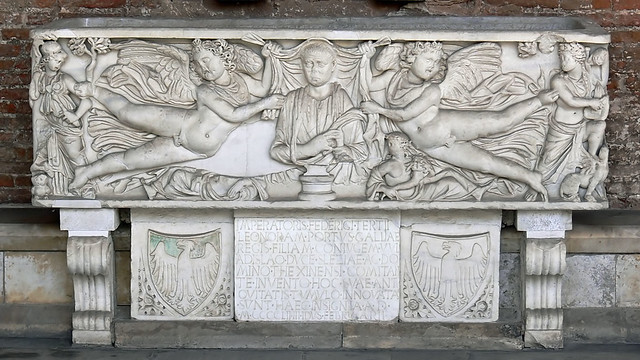Sarcophagi - Camposanto Pisa

These 2nd and 3rd century Roman sarcophagi in the Camposanto, Pisa, were the inspiration for the beginning of the Italian Renaissance sculpture of the 13th century. In particular the Phaedra Sarcophagus, pictured above, was the model for Nicola Pisano's Madonna, and animal scenes on the pulpit in the cathedral.

This example of 2nd-century AD funerary art, is likely dating to around 150–200 CE. Crafted from white Carrara marble, it was originally a pagan tomb from the Roman period, repurposed or relocated to the Camposanto during the medieval or Renaissance era as part of the cemetery's collection of antique artifacts. Its elaborate reliefs and inscriptions suggest it once commemorated a person of high status, possibly a military or civic figure, though its specific occupant remains unidentified. Set against the brick wall of the cloister, the sarcophagus (approximately 2.5 meters long and 1 meter high) exemplifies the Roman fusion of Hellenistic sculpture with imperial iconography, reflecting themes of triumph, eternal rest, and divine favor.
The frieze depicts a central male figure, likely the deceased, reclining in a pose reminiscent of a banquet scene (triclinium), a common Roman motif symbolizing the soul's eternal feast in the afterlife. He is seated or semi-reclining, dressed in a toga with one hand raised in a gesture of authority or blessing, the other resting on a scroll or cushion. His face, carved with stoic dignity, features a short beard and laurel-like hair, suggesting a connection to imperial or philosophical ideals.
Flanking him are four winged genii (victory or funerary spirits), depicted as youthful, semi-nude figures with dynamic, flowing drapery. Two genii on each side hold a canopy or curtain above the central figure, creating a theatrical frame that elevates him to divine status—echoing the apotheosis (ascension to godhood) scenes of emperors like Antoninus Pius. Their poses are lively: some lean forward, others stretch upward, their wings spread wide, with garments billowing as if caught in a celestial breeze. Small putti or additional figures at the ends (e.g., one holding a garland or torch) reinforce the theme of triumph over death, drawing from Greek Nike iconography adapted by Rome.


